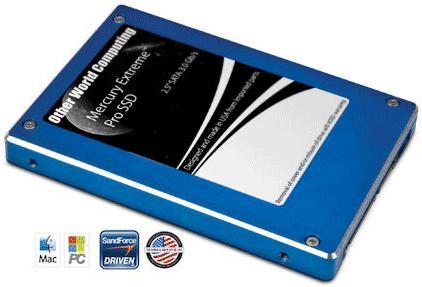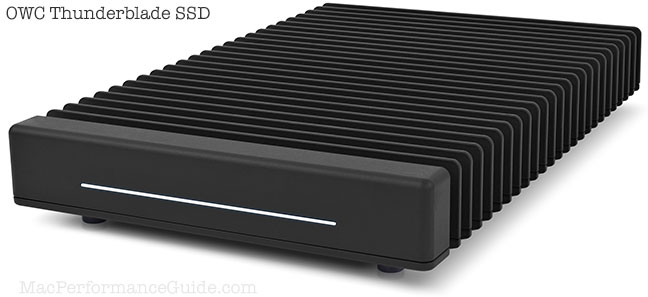
$220 SAVE $130 = 37.0% Western Digital 16.0TB Western Digital Ultrastar DC HC550 3.5-in… in Storage: Hard Drives
|

|

|

|

|

|

|

|

|

|
OWC Mercury Extreme Pro 3G 115GB SSD (25nm Flash)
Related: diglloydTools, DiskTester, hard drive, laptop, MacBook, memory, Other World Computing, Photoshop, SSD, storage
The OWC Mercury Extreme Pro 115GB SATA II SSD is the first of the March 2011 crop of SSDs to use 25nm flash memory.
The 115GB capacity versus previous 120GB drives with 34nm flash memory reflects the slightly less robust lifespan of 25nm flash memory, so that more flash memory cells are set aside (over-provisioning) for long term durability. Both 115GB and 120GB units actually have 128GB of flash memory inside.
The arrival of 25nm flash necessitated firmware changes to the Sandforce controller, so there is no guarantee of the same performance, as will be seen here.
Next-gen
The SATA III 6Gbps generation 2 Sandforce controller was imminent as I wrote this review. That controller is likely to prove faster than the existing SATA II controllers, even with the 25nm flash memory.
SSD performance vs a hard drive
Compared to a hard drive, SSD performance improvements come from multiple areas:
- Near-zero latency (delay in servicing I/O requests);
- No seek time (mechanical head movement);
- Ability to deal with very high numbers of simultaneous I/O requests;
- High data transfer rates, especially fast for reading data.
All three areas matter to performance, but how much each type of performance matters depends on the task.
Compressible vs incompressible data, flash memory lifespan
Some solid state drives compress the data sent to the drive with the goal of minimizing wear on the flash memory cells; if the data can be compressed, then fewer flash cells need to be written, thus reducing wear to the flash memory cells. This is an excellent strategy for reliability, but at present has a performance downside for incompressible data.
Incompressible data is commonplace: Photoshop files, JPEG files, digital camera RAW files, compressed TIF files, video files, Mac OS X system software and applications: all these files are already in compressed form, and are thus not compressible, and are very similar to pure random data.
The Sandforce controller used in the OWC SSDs (and various other brands), uses an aggressive compression strategy to provide long-term durability, but this attempt to compress incompressible data degrades write speed.
Personally, I’d gladly give up some longevity for elimination of the degraded write performance degrading feature, but Sandforce does not offer a controller without that behavior. The generation 2 Sandforce controller due out in April 2011 should offer improved performance in all areas, including compression.
Fortunately, read speed on incompressible data is still very fast. Read speed is far more important for most scenarios: video, sound, images, games, etc are all read (played) far more often then written (often just once). Yet there are scenarios in which write speed plays a role that is crucial. Users in such scenarios need to be aware of the behavior.
Photoshop CS5 with diglloydMedium benchmark
The diglloydMedium benchmark is disk intensive, since it needs about 16GB of memory for Photoshop, but the MacBook Pro has only 8GB as tested here. Photoshop thus spends most of its time writing to disk.
As confirmed with the DiskTester sustained transfer results below, the OWC Mercury Extreme Pro 115GB SSD shows impaired performance over its 34nmm 200GB sibling. Whether this is an issue with all SSDs using 25nm flash memory or specific to the 115GB model won’t be clear until other capacities are tested. It’s also likely that the Sandforce generation 2 controller will improve upon this, but that remains to be seen.
The difference is about 13% between the Apple SSD and the OWC 200GB Mercury Extreme Pro RE SSD. This is a worst case for the OWC SSD (mostly incompressible data).
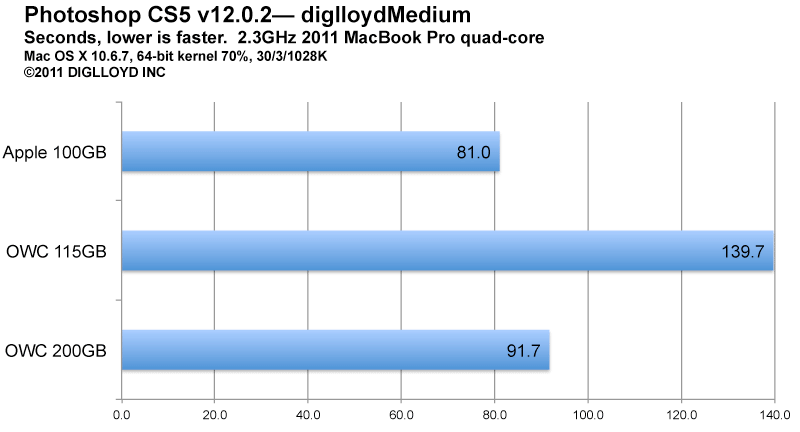
File copy test
All of my photographic work involves digital camera RAW files. About 95% of my data is image files, which are mostly incompressible. Incompressible data is a worst case for the Mercury Extreme Pro 115GB.
This test duplicates a 1 .74GB folder of DNG files (camera brand is irrelevant).
Because the test is both reading and writing the files, the equally weighted performance of read and write figure into the test time. For a music or video library, only reads would be relevant.

Reading files
These two tests are a read-only test using DiskTester read-files. Therefore, they show the performance to be expected reading a type of mostly incompressible data found on the drives of many Mac users: sound files and applications.
Here, the OWC Mercury Extreme Pro shows the best performance, suggesting that the Sandforce controller with 25nm flash has been optimized for read speed, which means that as a system drive it might be a very fine choice, since most of the time it’s all about reading (booting, launching applications, etc).
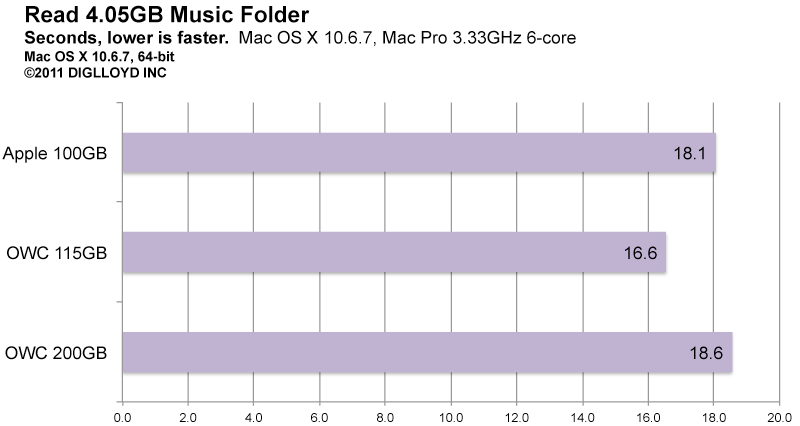
Read speed for the Applications folder is very fast with all the drives, with only small differences. The OWC Mercury Extreme Pro 115GB takes the speed lead, as it did above.
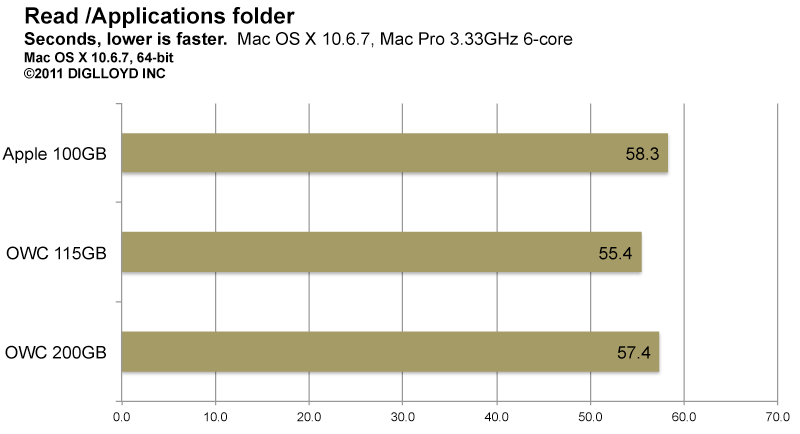
Performance with sustained transfers
Sustained transfer speed is relevant for many tasks, but by itself is only correlated with overall performance of any particular program; other factors could dominate.
I used DiskTester to test the sustained transfer performance. The fill-volume command is a demanding test that shows behavior over the full drive capacity.
I tested write/read speed both with all zero data (highly compressible), and also with pure random data (incompressible) sing the DiskTester command line using these two command, erasing the drive prior to each test.
Pure random data is incompressible.
disktester fill-volume owc115 <=== zeroes, highly compressible disktester fill-volume --fill random owc115 <=== pure random data
Sustained transfer rate
The OWC Mercury Pro 115GB SSD with the Sandforce controller shows a impaired write speed with pure random data. This appears to have worsened with the move to 25nm flash; prior tests with 34nm devices showed significantly higher write speeds of about 93MB/sec. A 2nd sample showed the same results.
As shown below, the OWC 115GB SSD can write compressible data at about 253 MB/sec, and read it at about 270.7MB/sec — this is nearly as fast as a SATA 3Gbps controller can deliver in the real world.
When forced to write incompressible data (worst case), speed drops to 75.9 MB/sec and read speed to 235.2 MB/sec. That’s a minor impact for reads, but a 70% drop in write speed.
But another random test drops even further (details further below). There also seems to be some impairment as the drive is nearly full.
All figures real world transfer rates through the Mac OS X file system.
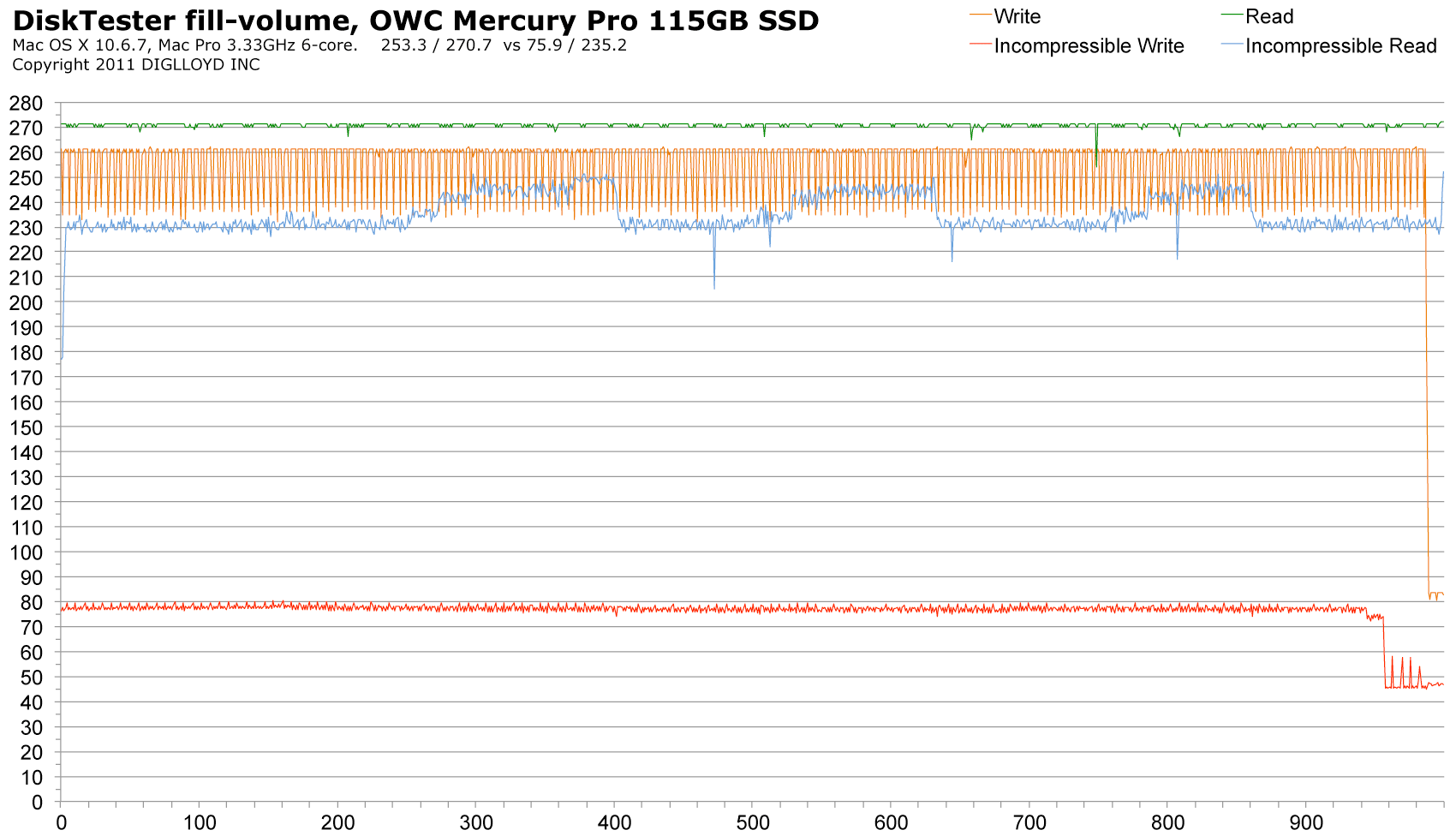
OWC Mercury Extreme Pro 115GB SSD (March 2011, 25nm flash memory)
A 2nd random pass
When I applied another DiskTester fill-volume random test to the OWC 115GB SSD: the write speed dropped to 56.5 MB/sec, though the read speed actually averaged 10MB/sec faster. A 3rd and 4th random pass showed no further drop in speed.
Something about pure random data with the new 25nm flash memory makes the Sandforce controller sluggish for writes. While the read/write performance is consistent across the capacity (not an erratic loss of general performance), the write speeds are slower than a laptop hard drive, or even Firewire 800.
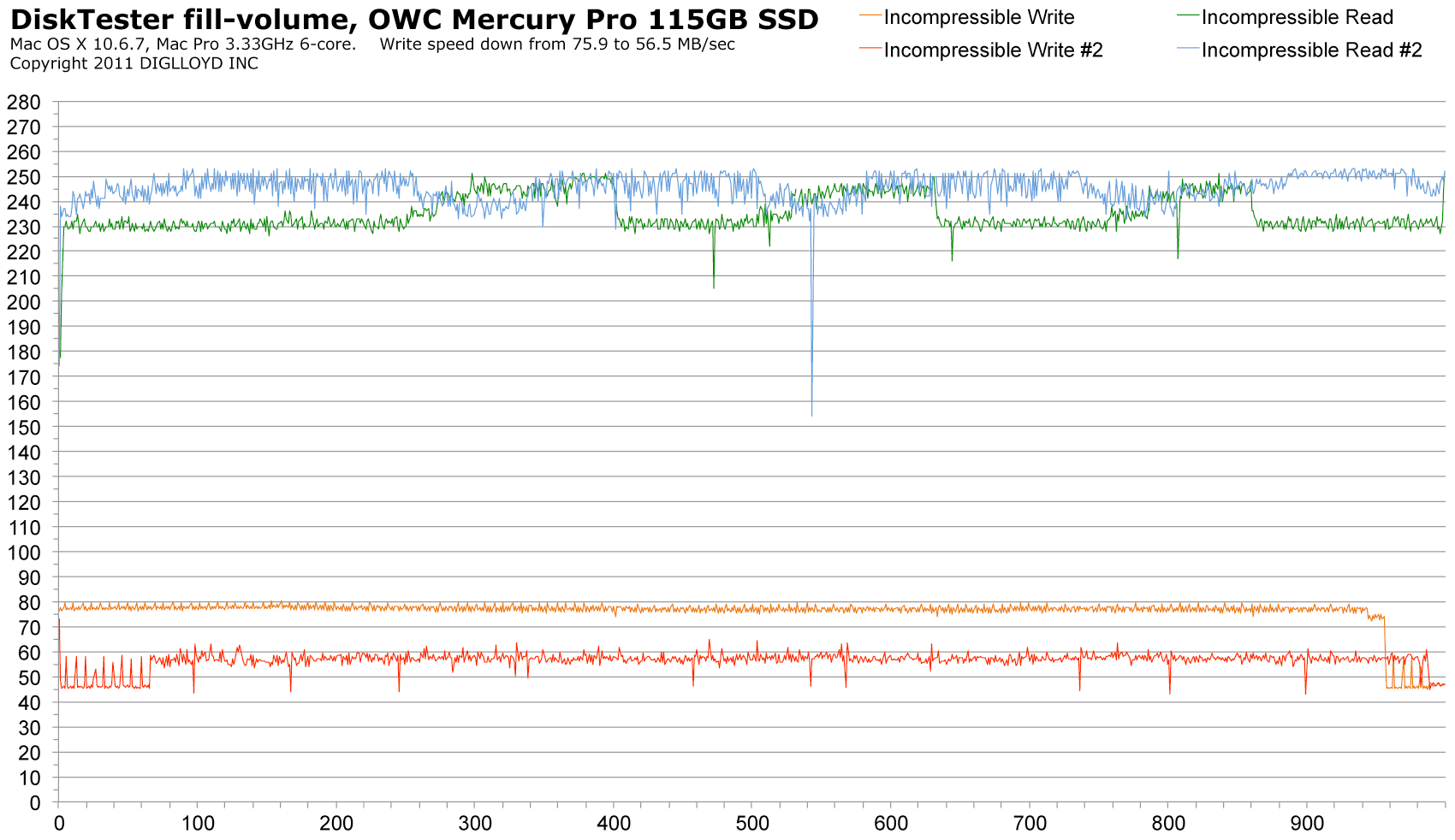
OWC Mercury Extreme Pro 115GB SSD (March 2011, 25nm flash memory)
Compared to OWC Mercury Extreme Pro RE 200GB (incompressible data)
An interesting behavioral difference emerges when the Mercury Extreme Pro 115GB (25nm flash) is compared to the Mercury Extreme Pro RE 200GB (34nm flash).
The Pro RE version is much faster on writes, but the Pro 115GB is faster with reads:
- The 200GB Mercury Extreme Pro RE averages 96.2 MB/sec, a whopping 70% faster than the 56.5 MB/sec of the 115GB Mercury Extreme Pro.
- The Mercury Extreme Pro 115GB is 16% faster on reads than the Mercury Extreme Pro RE 200GB.
- The Pro RE model offers much more consistent read speed, but at a 15% slower overall speed.
The new Sandforce firmware and 25nm flash behave quite differently than the 200GB model with 34nm flash.
115GB = Mercury Extreme Pro
200GB = Mercury Extreme Pro RE
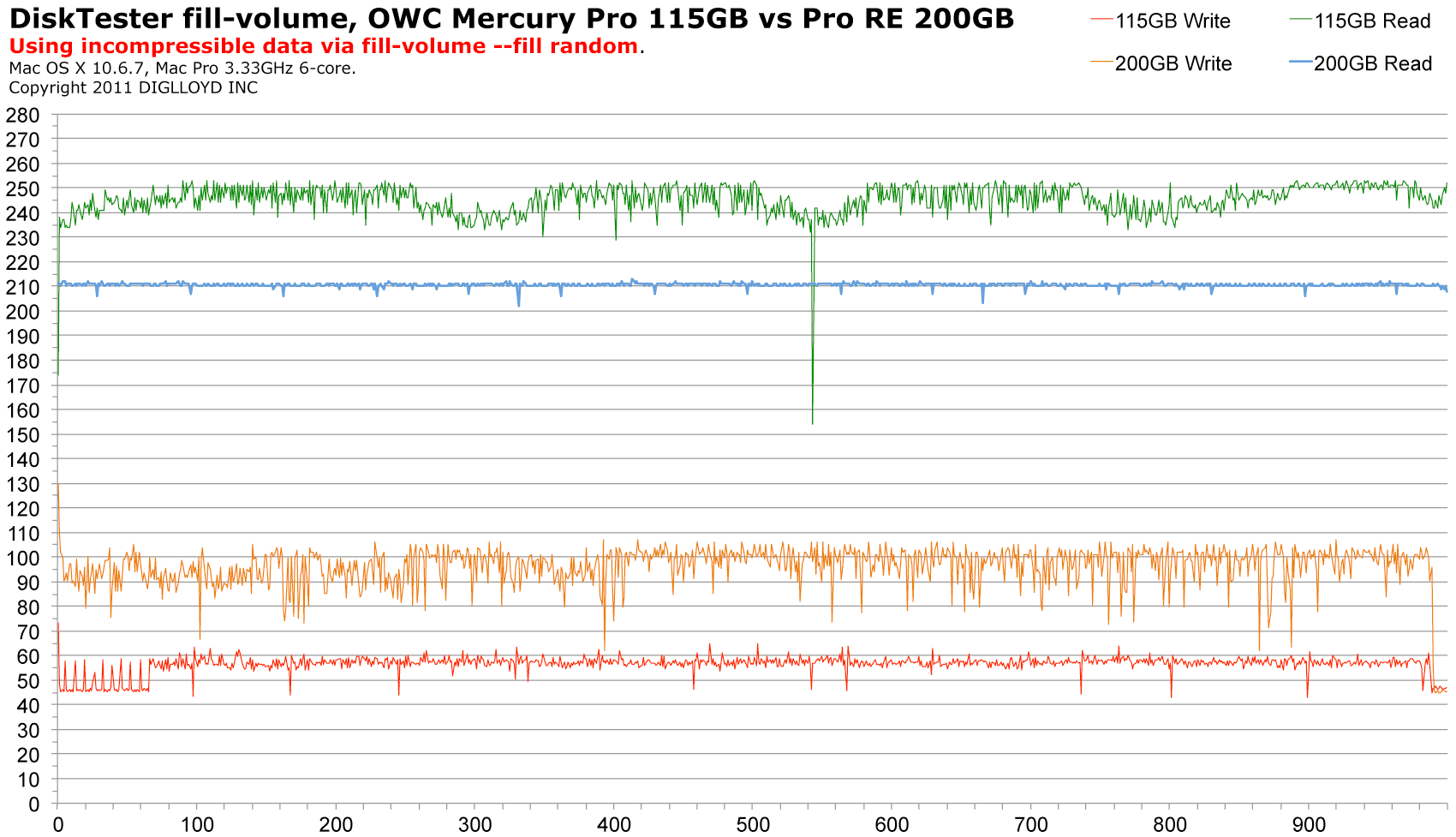
Conclusions
The OWC 115GB Mercury Extreme Pro SSD with the first generation Sandforce controller and 25nm flash memory shows slow write speeds for incompressible data, but was the fastest drive for read access in the tests here.
While much data is compressible and will show high write speeds with the OWC 115GB Mercury Extreme Pro SSD, sound and video and image files are all incompressible and thus will show the worst-case performance for writes. However, one should consider that media files are often written only once, and then read (played) numerous times, and read speeds are best with the OWC 115GB SSD.
Photography and RAW conversion
For my work as a photographer, write speed matters: converting a RAW file from my Nikon D3x generates a 130MB 16-bit TIF. With write speeds in the 57MB/sec range, the 115GB SSD thus imposes a minimum of 2.3 seconds just to write the file, which is almost 4X longer than some RAW file programs take to convert to 16-bit TIF. Thus, the workflow becomes I/O-bound (limited by drive speed). For users with 50MP or 80MP digital cameras, the speed would be in the 4-8 second range for a single file, neutering the CPU speed of even the fastest Mac Pro. Such users will want to ensure high write speed whether they choose SSD or hard drive storage.
Might be a moot point with 6G
With the imminent arrival (late March 2011) of SATA III 6Gbps drives utilizing the 2nd generation Sandforce controller (also with 25nm flash), buyers might want to wait to see how the new 2nd-gen SSDs play out before buying.
Need high performance in a Mac Pro or MacBook Pro?
Check out the MPG Pro Workstation and MPG Pro Laptop.
Seagate 22TB IronWolf Pro 7200 rpm SATA III 3.5" Internal NAS HDD (CMR)
SAVE $100


 diglloydTools™
diglloydTools™

